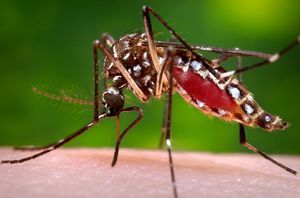Yellow Fever Vaccine: Difference between revisions
From MicrobeWiki, the student-edited microbiology resource
No edit summary |
|||
| Line 2: | Line 2: | ||
[[Image:Aedes_mosquito.jpg|thumb|300px|right|Photo of a female Aedes Aegypti, the most common vector of the Yellow Fever Virus. Photo taken by James Gathany for the CDC's Public Health Image Library]] | [[Image:Aedes_mosquito.jpg|thumb|300px|right|Photo of a female Aedes Aegypti, the most common vector of the Yellow Fever Virus. Photo taken by James Gathany for the CDC's Public Health Image Library]] | ||
<br>By Christopher Kei Helm<br> | <br>By Christopher Kei Helm<br> | ||
[[Image:YF_WHO_Map.jpg|thumb|300px|right|Map depicting geographic high risk areas for Yellow Fever, published by the WHO, July 2013.]] | [[Image:YF_WHO_Map.jpg|thumb|300px|right|Map depicting geographic high risk areas for Yellow Fever, published by the WHO, July 2013.]] | ||
[[Image:YF_Virion.jpg|thumb|300px|right|Diagram of a Flaviviridae virion. Note the three types of proteins composing the virion's membrane (E, M, C). Also notice the herringbone-like arrangements the E proteins form on the right hand diagram. Figure is the property of the SIB Swiss Institute of Bioinformatics]] | [[Image:YF_Virion.jpg|thumb|300px|right|Diagram of a Flaviviridae virion. Note the three types of proteins composing the virion's membrane (E, M, C). Also notice the herringbone-like arrangements the E proteins form on the right hand diagram. Figure is the property of the SIB Swiss Institute of Bioinformatics]] | ||
[[Image:Flavivirus_Life_Cycle.jpg|thumb|300px|right|Diagram of the Flavivirus' life cycle. Notice the initial binding to the host cell and the clathrin mediated endocytosis that follows the initial binding. Then the viral membrane fuses with the host's endosome to expose the viral ssRNA to the endoplasmic reticulum (ER). There, the ssRNA is transcribed and copied to make new viral proteins and new ssRNA. The viral particles are assembled and form a immature virion by budding off of the ER. After budding off, the immature virion moves to the Golgi. Moving from the Golgi to the host's membrane, the cell undergoes cleavages that cleave the prM protein into M proteins, maturing the virion before being secreted out of the host cell. Additionally, notice how the immature virion has a rough, spiked surface in contrast to the smooth surface of the mature virion. Diagram by Ted C. Pierson, NIH National Institute of Allergy and Infectious Diseases]] | [[Image:Flavivirus_Life_Cycle.jpg|thumb|300px|right|Diagram of the Flavivirus' life cycle. Notice the initial binding to the host cell and the clathrin mediated endocytosis that follows the initial binding. Then the viral membrane fuses with the host's endosome to expose the viral ssRNA to the endoplasmic reticulum (ER). There, the ssRNA is transcribed and copied to make new viral proteins and new ssRNA. The viral particles are assembled and form a immature virion by budding off of the ER. After budding off, the immature virion moves to the Golgi. Moving from the Golgi to the host's membrane, the cell undergoes cleavages that cleave the prM protein into M proteins, maturing the virion before being secreted out of the host cell. Additionally, notice how the immature virion has a rough, spiked surface in contrast to the smooth surface of the mature virion. Diagram by Ted C. Pierson, NIH National Institute of Allergy and Infectious Diseases]] | ||
Revision as of 05:15, 22 April 2014
Introduction
By Christopher Kei Helm

Diagram of the Flavivirus' life cycle. Notice the initial binding to the host cell and the clathrin mediated endocytosis that follows the initial binding. Then the viral membrane fuses with the host's endosome to expose the viral ssRNA to the endoplasmic reticulum (ER). There, the ssRNA is transcribed and copied to make new viral proteins and new ssRNA. The viral particles are assembled and form a immature virion by budding off of the ER. After budding off, the immature virion moves to the Golgi. Moving from the Golgi to the host's membrane, the cell undergoes cleavages that cleave the prM protein into M proteins, maturing the virion before being secreted out of the host cell. Additionally, notice how the immature virion has a rough, spiked surface in contrast to the smooth surface of the mature virion. Diagram by Ted C. Pierson, NIH National Institute of Allergy and Infectious Diseases
Section 1
Include some current research, with at least one figure showing data.



